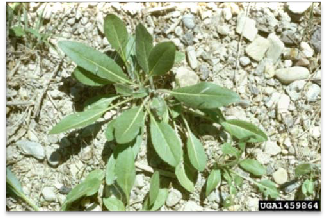Also Known as: Marlahan mustard and occasionally Asp of Jerusalem.
Dyer’s woad is a Class A Noxious Weed. Class A noxious weeds are non-native species that are limited in distribution in Washington State. State law requires that these weeds be eradicated.
Dyer’s woad (Isatis tinctoria L.), a member of the mustard family, is native to central Asia and Russia. Used by early colonists as a textile dye crop, dyer’s woad was accidentally introduced in California and Utah in contaminated crop seed. Dyer’s woad is described as a winter annual, biennial, or short-lived perennial because it typically persists more than one year. It begins as a low-lying rosette. Rosette leaves are bluish-green, stalked, succulent, and covered with fine hairs.  Rosette leaves also have a distinguishing cream-colored midvein, which is also characteristic of the plant’s stem leaves. After overwintering, the rosette bolts in the spring, producing many flowering stalks, which become stiff or somewhat woody with maturity. Stems are generally about 2 feet tall, but can reach up to 4 feet in height. Stem leaves are lance-shaped, alternate, and clasp the stem. Bright yellow flowers appear in abundance during spring and into summer in terminal clusters at branch ends, creating a dense, flat-topped inflorescence. Individually, the flowers are cross-shaped and have four petals, each of which is about 1/8 inch wide and just over that in length. After flowering, the plant produces flattened, teardrop-shaped seed pods that hang from small stalks and turn dark purplish-brown or black with age. Each pod contains a single seed. An average dyer’s woad plant produces 350-500 seeds, although some plants can produce as many as 10,000 seeds in one year. The root system of dyer’s woad consists of a thick taproot, which can exceed 5 feet in depth, and lateral roots. Unlike other mustard species, dyer’s woad does not depend on disturbance to invade a site. It establishes in areas with poor, dry soils such as roadsides, and spreads from there by seed to well-vegetated rangeland sites, croplands, and open forests.
Rosette leaves also have a distinguishing cream-colored midvein, which is also characteristic of the plant’s stem leaves. After overwintering, the rosette bolts in the spring, producing many flowering stalks, which become stiff or somewhat woody with maturity. Stems are generally about 2 feet tall, but can reach up to 4 feet in height. Stem leaves are lance-shaped, alternate, and clasp the stem. Bright yellow flowers appear in abundance during spring and into summer in terminal clusters at branch ends, creating a dense, flat-topped inflorescence. Individually, the flowers are cross-shaped and have four petals, each of which is about 1/8 inch wide and just over that in length. After flowering, the plant produces flattened, teardrop-shaped seed pods that hang from small stalks and turn dark purplish-brown or black with age. Each pod contains a single seed. An average dyer’s woad plant produces 350-500 seeds, although some plants can produce as many as 10,000 seeds in one year. The root system of dyer’s woad consists of a thick taproot, which can exceed 5 feet in depth, and lateral roots. Unlike other mustard species, dyer’s woad does not depend on disturbance to invade a site. It establishes in areas with poor, dry soils such as roadsides, and spreads from there by seed to well-vegetated rangeland sites, croplands, and open forests.
Control Methods
Physical/Mechanical: To avoid seed spread, control efforts should be undertaken before seed production occurs. If plants are pulled or dug after flowering, all plant parts should be removed from the site. Small populations of dyer’s woad can be handpulled, although the plant’s deep roots can make removal difficult. Mechanically severing the plant can result in regeneration unless several inches of the root are removed. Repetitive cultivation can also be effective.
Chemical: Several chemicals are available and generally should be applied to rosettes. Metsulfuron (Escort®) plus surfactant and 2,4-D is often recommended. Escort® and Telar® are commonly used for control, but can cause damage to desirable plant species and may have residual impacts.
More information can be found in the PNW Weed Management Handbook
USE PESTICIDES WITH CARE. Apply them only to plants, animals, or sites listed on the label. When mixing and applying pesticides, follow all label precautions to protect yourself and others around you. It is a violation of the law to disregard label directions. Store pesticides in their original containers and keep them out of the reach of children, pets, and livestock.
Biological: A native fungal rust, Puccinia thlaspeos, has proved effective in keeping dyer’s woad populations in check. Several insect species are being tested for biocontrol potential, although none has currently been approved for lease. Although dyer’s woad is not toxic, it is unpalatable to livestock.
Questions: contact Steve Van Vleet or phone (509) 397 – 6290
Photo credits included in PDF




